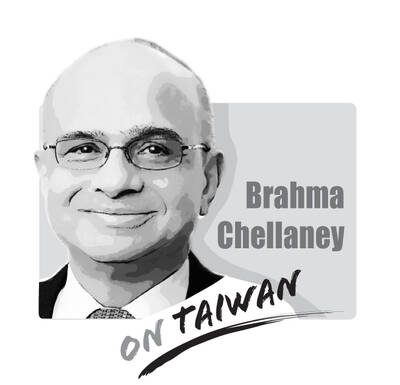A group of young Maori from New Zealand has visited Taiwan to seek their roots, while a Japanese anthropologist has speculated that a branch of Japanese ancestry might have traveled to Kyushu Island from Taiwan.
As people from other places seek their roots in Taiwan, it is ironic that the high-school curriculum guidelines claim that the nation is a “Han Chinese immigrant society” and that Taiwanese’s ancestors came from China.
Recorded history in Taiwan started during the Dutch colonial rule. Documents show that, there were more than 200 plains Aboriginal communities at that time, the largest being the community in what is today Tainan’s Madou District (麻豆) with a population of more than 3,000.
It was surrounded by smaller communities, whose populations were not recorded.
Among highland Aborigines, the Dutch had most contact with the Paiwan people.
The plains Aborigines and the Paiwan people were the main forebears of Taiwanese. This can be seen from more than 30 lines of evidence, including Aboriginal household and tax records, and farming data.
Why then the distortion that Taiwan is a “Han Chinese immigrant society”? The causes are Sinicization, bestowing surnames and using genealogies to connect Taiwan to China.
In a report on Taiwan affairs to Emperor Yongzheng of the Qing Dynasty, then-prefectural magistrate Shen Qiyuan (沈起元) recorded the policy of “turning naturalized Aborigines into Han Chinese and unnaturalized Aborigines into naturalized ones.”
The book A Brief History of Taiwan writes that in Aboriginal communities near today’s Tainan and Kaohsiung, people mostly spoke Mandarin or the dialects of Quanzhou and Zhangzhou from China’s Fujian Province — just as Han Chinese did.
During the reign of Emperor Qianlong (乾隆), the Taiwan Prefecture Gazetteer recorded that people in naturalized Aboriginal communities mostly dressed like Han Chinese and could speak a little Chinese.
The book Annals of Taiwan Province, published by the Taiwan Province Archives — what is today Taiwan Historica — said that Qianlong in 1785 implemented a compulsory measure to bestow surnames, the most concrete proof of Sinicization.
How did Qianlong bestow surnames? The residents of an Aboriginal community were simply forced to adopt the surname of the Chinese official who was sent to them. No wonder it was common to find villages where people had the same surname, despite not being related.
In 1885, Chinese official Liu Mingchuan (劉銘傳) wrote in a report to the emperor that it was inappropriate for the Qing Empire to turn Taiwan into a Chinese province.
Aborigines and Taiwanese in the eight coastal counties of the time accounted for 60 and 40 percent of the population respectively, Liu wrote.
Taiwan was still an Aboriginal society in 1885. It in 1895 entered half a century of Japanese colonial rule, but the attempt at Japanization eventually failed. In 1951, Chiang Kai-shek (蔣介石) began to bestow surnames and genealogies, and, absurdly, some siblings were given different surnames.
Chiang even “amended” 791 Taiwanese genealogies, or about 65 percent of them.
Even after all these distortions, census data in 1956 showed that the 940,000 Chinese in Taiwan at the time only accounted for 10 percent of the population, showing that Taiwan is not a “Han Chinese immigrant society.”
How will Taiwanese face history if the curriculum guidelines remain unchanged?
Sim Kiantek is a former associate professor of business administration at National Chung Hsing University.
Translated by Eddy Chang

Taiwan stands at the epicenter of a seismic shift that will determine the Indo-Pacific’s future security architecture. Whether deterrence prevails or collapses will reverberate far beyond the Taiwan Strait, fundamentally reshaping global power dynamics. The stakes could not be higher. Today, Taipei confronts an unprecedented convergence of threats from an increasingly muscular China that has intensified its multidimensional pressure campaign. Beijing’s strategy is comprehensive: military intimidation, diplomatic isolation, economic coercion, and sophisticated influence operations designed to fracture Taiwan’s democratic society from within. This challenge is magnified by Taiwan’s internal political divisions, which extend to fundamental questions about the island’s identity and future
The narrative surrounding Indian Prime Minister Narendra Modi’s attendance at last week’s Shanghai Cooperation Organization (SCO) summit — where he held hands with Russian President Vladimir Putin and chatted amiably with Chinese President Xi Jinping (習近平) — was widely framed as a signal of Modi distancing himself from the US and edging closer to regional autocrats. It was depicted as Modi reacting to the levying of high US tariffs, burying the hatchet over border disputes with China, and heralding less engagement with the Quadrilateral Security dialogue (Quad) composed of the US, India, Japan and Australia. With Modi in China for the
The Chinese Nationalist Party (KMT) has postponed its chairperson candidate registration for two weeks, and so far, nine people have announced their intention to run for chairperson, the most on record, with more expected to announce their campaign in the final days. On the evening of Aug. 23, shortly after seven KMT lawmakers survived recall votes, KMT Chairman Eric Chu (朱立倫) announced he would step down and urged Taichung Mayor Lu Shiow-yen (盧秀燕) to step in and lead the party back to power. Lu immediately ruled herself out the following day, leaving the subject in question. In the days that followed, several
The Jamestown Foundation last week published an article exposing Beijing’s oil rigs and other potential dual-use platforms in waters near Pratas Island (Dongsha Island, 東沙島). China’s activities there resembled what they did in the East China Sea, inside the exclusive economic zones of Japan and South Korea, as well as with other South China Sea claimants. However, the most surprising element of the report was that the authors’ government contacts and Jamestown’s own evinced little awareness of China’s activities. That Beijing’s testing of Taiwanese (and its allies) situational awareness seemingly went unnoticed strongly suggests the need for more intelligence. Taiwan’s naval